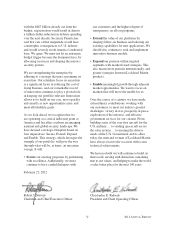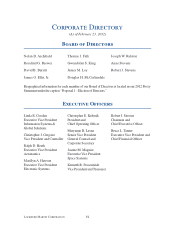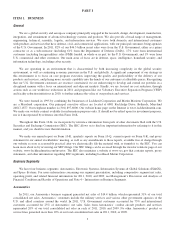Lockheed Martin 2011 Annual Report Download - page 17
Download and view the complete annual report
Please find page 17 of the 2011 Lockheed Martin annual report below. You can navigate through the pages in the report by either clicking on the pages listed below, or by using the keyword search tool below to find specific information within the annual report.We depend heavily on U.S. Government contracts. A decline or reprioritization of funding in the U.S. defense budget
or delays in the budget process could adversely affect our ability to grow or maintain our sales, earnings, and cash
flow.
We derived 82% of our sales from U.S. Government customers in 2011, including 61% from the DoD. We expect to
continue to derive most of our sales from work performed under U.S. Government contracts. Those contracts are conditioned
upon the continuing availability of Congressional appropriations. Congress usually appropriates funds on a fiscal-year basis
even though contract performance may extend over many years.
The programs in which we participate must compete with other programs and policy imperatives for consideration
during the budget and appropriation process. Concerns about increased deficit spending, along with continued economic
challenges, continue to place pressure on U.S. and international customer budgets. While we believe that our programs are
well aligned with national defense and other priorities, shifts in domestic and international spending and tax policy, changes
in security, defense, and intelligence priorities, the affordability of our products and services, general economic conditions
and developments, and other factors may affect a decision to fund or the level of funding for existing or proposed programs.
During 2011, the U.S. Government was unable to reach agreement on budget reduction measures required by the Budget
Control Act of 2011 (Budget Act) passed by Congress. Unless Congress and the Administration take further action, the
Budget Act will trigger automatic reductions in both defense and discretionary spending in January 2013. While the impact
of sequestration is yet to be determined, automatic across-the-board cuts would approximately double the $487 billion
top-line reduction already reflected in the defense funding over a ten-year period, with a $52 billion reduction occurring in
the government’s fiscal year 2013. The resulting automatic across-the-board budget cuts in sequestration would have
significant consequences to our business and industry. There would be disruption of ongoing programs and initiatives,
facilities closures and personnel reductions that would severely impact advanced manufacturing operations and engineering
expertise, and accelerate the loss of skills and knowledge, directly undermining a key provision of the new security strategy,
which is to preserve the industrial base. In December 2011, Congress passed an omnibus appropriations act for fiscal 2012 to
finance all U.S. Government activities through September 30, 2012, the end of its fiscal year. This full year method of
financing eliminated much of the uncertainty and inefficiency in procurement of products and services that characterized the
government’s first quarter of fiscal year 2012 when the operations of the federal government were financed through a series
of continuing resolution temporary funding measures.
Under such conditions, large or complex programs are potentially subject to increased scrutiny, particularly those
programs that have experienced performance challenges. Our largest program, the F-35, represented 13% of our consolidated
sales in 2011, and is expected to represent a higher percentage of our sales in future years. For additional information
regarding the F-35 program, see “Status of the F-35 Program” in Management’s Discussion and Analysis of Financial
Condition and Results of Operations.
We offer a diverse range of defense, homeland security, and information technology products and services. We believe
that this makes it less likely that cuts in any specific contract or program will have a long-term effect on our business;
however, termination of multiple or large programs or contracts could adversely affect our business and future financial
performance. We could incur expenses beyond those that would be reimbursed if one or more of our existing contracts were
terminated for convenience due to lack of funding or other reasons. Potential changes in funding priorities may afford new or
additional opportunities for our businesses in terms of existing, follow-on, or replacement programs. While we would expect
to compete, and be well positioned as the incumbent on existing programs, we may not be successful, or the replacement
programs may be funded at lower levels.
In years when the U.S. Government does not complete its budget process before the end of its fiscal year
(September 30), government operations typically are funded through a continuing resolution that authorizes agencies of the
U.S. Government to continue to operate, but does not authorize new spending initiatives. When the U.S. Government
operates under a continuing resolution, delays can occur in the procurement of products and services. Historically, this has
not had a material effect on our business; however, should a continuing resolution be prolonged further or extended through
the entire government fiscal year, it may cause procurement awards to shift and cause our revenues to vary between periods.
During periods covered by continuing resolutions (or until the regular appropriation bills are passed), we may
experience delays in procurement of products and services due to lack of funding; and those delays may affect our results of
operations. At times, we may continue to work without funding, and use our funds, in order to meet our customer’s desired
delivery dates for products or services. It is uncertain at this time which of our programs’ funding could be reduced in future
years or whether new legislation will be passed by Congress in the next fiscal year that could result in additional or
alternative funding cuts.
9
























